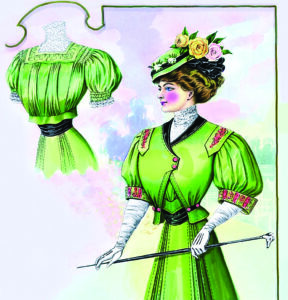(Editor’s note: This is the third of a three-part series featuring art and antiques of the Eastern Shore. DeeDee Wood is the owner of Black Cat Curiosities, an online antiques research and sales venue.)

Arsenic could be found in many color agents, however, and it was not simply limited to green. Unfortunately, the bright, vivid green that was so deadly and effective in harming people was also coveted greatly in fashion during this era. (Photos courtesy DeeDee Wood)
Arsenic is a by-product of the industrial age, a bright green metalloid byproduct of the copper industry from Victorian times.
Without proper knowledge of chemicals, alloys and airborne contaminants, the Victorians literally took life into their own hands when developing products using this dangerous, deadly wonder.
The green color in arsenic is one form that the Victorians used. Swedish chemist and scientist Carl Scheele found the striking shade of green in his research with the compound, and it was aptly named “Scheele’s Green.”
Arsenic could be found in many color agents, however, and it was not simply limited to green. Unfortunately, the bright, vivid green that was so deadly and effective in harming people was also coveted greatly in fashion during this era.
Arsenic touched many parts of the Victorian life. The substance could be found in green food coloring and dyes, sugars and food bulk, coloring for wreaths and scarves worn about the head and neck, and a serious amount in beautiful wallpaper at the time. Arsenic could also be found in clothing, bedding, linens, undergarments, medicines and powdered versions used for all sorts of things. Last but not least it was found in the mixing of topsoil, agricultural additives, as well as, shockingly, beauty products to apply to the face and body, such as face powder, and children’s toys and products. If you lived in Victorian times during the late 19th century, there was a good chance your life involved some sort of use of an arsenic product.
A popular piece of study for any scholar or writer researching the use of arsenic in antiquity would probably notice you will be inundated with wallpaper studies.
Due to the need to highly colorize bright, intricate, complicated patterns with many color schemes and handwork, manufacturers such as British wallpaper manufacturer and copper mine tycoon William Morris’s arsenic-rich wallpapers were extremely fashionable and a hot commodity during the late 19th century. When confronted with the insinuation that arsenic was killing people, Morris denied such accusations and said that there were other reasonable explanations for illnesses occurring with the association of arsenic.
The vibrant “Scheele’s Green” was so popular during this era of decor, that it was used in practically every wallpaper pattern in the Victorian home, as well as paint. By the 1850s, it was estimated that there were over one hundred million square feet of this green wallpaper in the UK. Wallpaper was more deadly than most items, due to arsenic content, as it was ever-present in a room. Particles would flake off of the wallpaper as fibers and get into lung linings, and the wallpaper itself produced a gas called trimethylarsine that leached into every pore of the body.
It didn’t help that during Victorian times, one would keep the window closed most days, as the heavy air of the industrial revolution would leach into your home and find other ways to kill you.
Eventually, as illness began to strike down more and more of society, such as factory workers, children, women who used these beauty products, or the general public, who began to be slowly poisoned by the very thing decorating their homes and lives. Factory workers were beginning to die, due to working with the very dangerous green arsenic dye and powders used as a colorant and additive in many things.
The main form of any arsenic poison was inhalation of tiny particles from the manufacturing process, or a direct process of the arsenic finding open wounds or soft openings in the body, and going directly to the bloodstream, a more deadly way to be poisoned.
When the press began to take notice, in the late 19th and early 20th centuries, people did not stop using arsenic. Victorians were very attached to their brands, wanted their colorants, and some refused to address the issue, especially manufacturers who were making money off of the product. Eventually, as scientific knowledge increased, and the facts behind arsenic were more well known, alternative, safer solutions were produced and promoted, such as William Morris developing an arsenic-free version of his colorful wallpaper.
In 1903 Britain passed law into their legislative body regarding safe levels of arsenic in food and beverage, but yet never addressed items such as the heavily scrutinized wallpaper, and other items of décor.
Some scholars point out that by the time these issues were addressed, the green in many products was no longer such a popular option for additives and décor, and the issue was never fully addressed.
Arsenic can still be present in old products from the Victorian age, and with careful, more modern studies and testing, it can be detected, assessed and dealt with in a scientific way. Building codes and proper licensed, metered, lawful removal of such products from the home, as well as restoration, bring new hope for safe, healthy standards in dealing with Victorian arsenic.
The modern techniques and study bring about a safer fruition and knowledge of how to handle the deadly green wonder of the Victorian age and the people who used it to beautify, color and enhance their lives.



